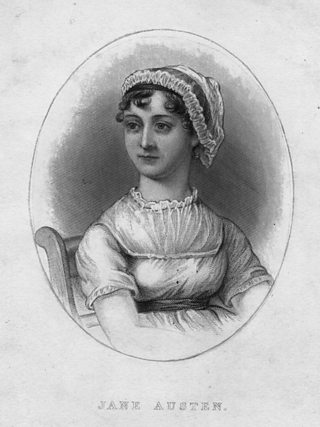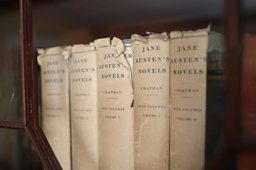Who was Jane Austen's real life Mr Darcy?
Jane Austen’s novels have inspired countless films, plays, and dramas, and have been translated into almost 50 different languages. But how did an 18th century woman create stories that are still loved today? What makes her characters so timeless? And, while we know all about her heroes and heroines, what do we know about the author herself? All is answered in A Short History of Jane Austen, on 大象传媒 Sounds.
Written by Linda Harrison, narrated by John Hopkins and with insights from English literature professor Janine Barchas, here are some of the facts we learned about the author’s life and works.
1. The Austens were a creative family.
Jane’s father, the Reverend George Austen, influenced her passion for literature, allowing her access to his extensive library. He encouraged her early writing, which she read aloud to the family. The Austens delighted in words: they wrote poems, put on private theatricals, and created word games for each other to solve.

2. She showed ambition from a young age.
In 1789, at the age of 14, Austen finished writing Love and Friendship, a parody of overly dramatic novels that were popular at the time. She transcribed her early works for juvenilia that she wrote at a young age into three volumes, which, argues Professor Janine Barchas, shows she imagined herself early on as a published author.
3. She had one known love interest.
He was a young Irishman named Tom Lefroy, who Jane met in December 1795 while he visited his aunt and uncle. He was handsome, witty and well-read. Over the following weeks they went on to meet at balls and parties and she would write about their flirtations to her sister Cassandra. It’s hard to tell from the tone of her letters today how serious the love affair was – but in any case, it wasn’t meant to be. He wasn’t wealthy enough for their marriage to be financially viable, and their dalliance ended when his family sent him away. The rest of Austen’s love life remains a mystery.
4. Her writing style was revolutionary.
Austen was an early user of third person omniscient narration in her novels. Her stories are told from an all-seeing, all knowing point of view. She jumps into the inner thoughts and feelings of not only the main protagonist, but many different characters.
5. She was determined to be published.
When Austen was 22, her father sent an early draft of Pride and Prejudice to a London publisher, who made the mistake of turning it down. But she vowed to keep trying.
6. She received one known proposal of marriage.
Within her first year living in Bath in1801, Jane received a proposal from the 21-year-old Harris Bigg-Wither, the wealthy brother of her close friend. He was heir to his father’s estate, but (sadly for him) is described as having been plain and awkward. She initially accepted – but then changed her mind after sleeping on it. Awkward.

7. Her first published novel was Sense and Sensibility.
After some failed attempts by Austen to be published, Sense and Sensibility was released in 1811. Austen had to cover the costs of paper and printing, and the book was published anonymously – with a title page only stating that it was “by a lady”. The first print run sold out in two years, with a profit of £140 – or around £11,000 in today’s money. After this, the popularity of her writing only grew.
8. Some of her characters were named after real people.
These included Mr Darcy of Pride and Prejudice, Wentworth of Persuasion, and the Dashwoods of Sense and Sensibility. It would have been considered a daring move for her to reference the Dashwood name at that time: they were associated with anti-Catholic rituals, sex scandals, Bacchanalia, and royal scandals.
9. One of her biggest fans was the Prince Regent.
By her late 30s, Austen's novels had become more fashionable, and her identity was an open secret despite their anonymous title pages. Even the Prince Regent’s librarian requested that she dedicate her next novel to him. Though Austen was hardly enamoured by the Prince, she couldn’t exactly turn him down – and dedicated the novel Emma to him in 1816.
10. Her final novel was left unfinished.
While writing what was to be her final, unfinished novel Sanditon, Austen became ill with fever, fatigue, rheumatic pains and stomach irritability. These are now widely believed to have been the symptoms of Addison’s disease, a rare disorder of the adrenal glands. Her condition worsened on the 18th July 1817, and she died at the age of 41. She is buried at Winchester Cathedral.
11. Her success was delayed by decades.
While her popularity as a writer certainly grew during her lifetime, her fame exploded posthumously after the novels went out of copyright. From around 1840, her books started to be sold at pennies a copy – some of the earliest mass market paperbacks. Her novels were even prescribed to soldiers during the First World War. Her readership only continues to grow with each new generation.

More from the 大象传媒
-
![]()
The Allusionist
An entertainment show about how language works and why we should care.
-
![]()
History's Secret Heroes
Helena Bonham Carter shines light on extraordinary stories from World War Two.
-
![]()
Shedunnit
Unravelling the mysteries behind classic detective stories.
-
![]()
You're Dead To Me
The history podcast for people who don't like history... and those who do. Greg Jenner brings together the best names in comedy and history to learn and laugh about the past.





